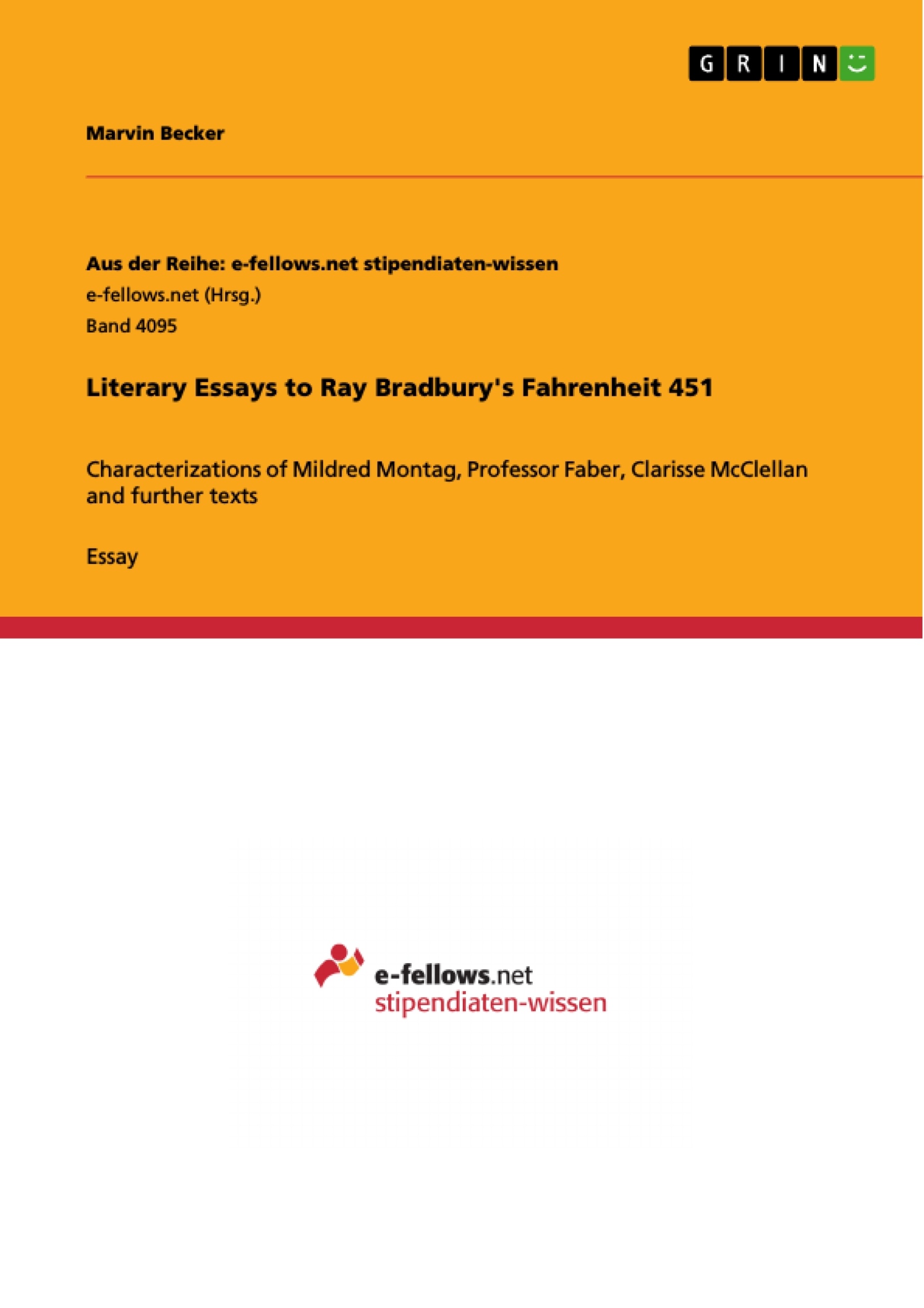This paper contains a total of 5 analytical texts on Ray Bradbury's "Fahrenheit 451" - including three characterizations on important characters from the novel (Mildred Montag, Professor Faber, Clarisse McClellan), a summary, and an analysis on the importance of the books in the plot. The texts are perfect for learning, matching or exam preparation!
Table of Contents
- Summary of a Given Extract
- Written Characterization of Mildred Montag
- Written Characterization of Professor Faber
- Written Characterization of Clarisse McClellan
- Analysis of the Role of Books in "Fahrenheit 451"
Objectives and Key Themes
This text aims to analyze characterizations and themes within Ray Bradbury's "Fahrenheit 451," focusing on specific characters and their relationships to technology and societal norms. The analysis delves into the portrayal of key characters and their impact on the narrative.
- Character analysis of Mildred Montag, Professor Faber, and Clarisse McClellan
- The impact of technology on human relationships and emotional connection
- The role of books and literature in a dystopian society
- Exploration of conformity and rebellion within the novel's context
- The effects of mass media consumption on individual identity
Chapter Summaries
Summary of a Given Extract: This section summarizes an excerpt from Part One of "Fahrenheit 451," focusing on a conversation between Guy Montag and his wife, Mildred. Mildred's obsession with her Seashell radio and the parlor walls (television screens) highlights her emotional detachment and superficial engagement with life. Montag's internal struggle reveals his growing disillusionment with his conformist lifestyle and the emotional coldness he witnesses in his marriage. He questions their relationship and contemplates the meaninglessness of his wife's near-fatal overdose, illustrating the emotional sterility of their dystopian society. The extract underscores the dehumanizing effects of technology and the lack of genuine human connection.
Written Characterization of Mildred Montag: This chapter provides a detailed analysis of Mildred Montag's character, focusing on her relationship with Guy Montag and the influence of electronic devices on her life. Mildred is characterized by her disinterest in her husband and her overwhelming dependence on mass media for entertainment. Her inability to recall important details about her marriage emphasizes her emotional detachment and superficiality. The chapter argues that Mildred's excessive consumption of media contributes to her jaded personality and hinders genuine connection with Montag. Their relationship is depicted as emotionally shallow and transactional, lacking empathy and honest communication, largely due to Mildred's obsession with technology.
Keywords
Fahrenheit 451, Ray Bradbury, Mildred Montag, Professor Faber, Clarisse McClellan, dystopian society, technology, mass media, human relationships, conformity, rebellion, emotional detachment, literature, books.
Fahrenheit 451: A Deep Dive - Frequently Asked Questions
What is this document about?
This document provides a comprehensive preview of a text analyzing characterizations and themes in Ray Bradbury's "Fahrenheit 451." It includes a table of contents, objectives, key themes, chapter summaries, and keywords. The analysis focuses on Mildred Montag, Professor Faber, and Clarisse McClellan, exploring their relationships with technology and societal norms.
What are the main themes explored in the analysis?
The analysis delves into several key themes present in "Fahrenheit 451," including the impact of technology on human relationships and emotional connection, the role of books and literature in a dystopian society, conformity versus rebellion, and the effects of mass media consumption on individual identity.
Which characters are analyzed in detail?
The analysis focuses primarily on three characters: Mildred Montag, Professor Faber, and Clarisse McClellan. Each character's portrayal is examined in detail, exploring their motivations, relationships, and impact on the narrative.
What is included in the chapter summaries?
The chapter summaries provide detailed overviews of key sections of the analysis. For example, there is a summary of an extract focusing on a conversation between Guy and Mildred Montag, highlighting Mildred's detachment and Montag's disillusionment. A separate summary focuses on the characterization of Mildred Montag, emphasizing her dependence on technology and emotional distance.
What is the purpose of this document?
The purpose is to provide a structured and professional overview of the analysis of "Fahrenheit 451," aiding in understanding its key arguments and findings. It acts as a preview for readers interested in learning more about the book's themes and characterizations.
What are the keywords associated with this analysis?
The keywords include: Fahrenheit 451, Ray Bradbury, Mildred Montag, Professor Faber, Clarisse McClellan, dystopian society, technology, mass media, human relationships, conformity, rebellion, emotional detachment, literature, and books.
What kind of audience is this document intended for?
This document is intended for an academic audience interested in literary analysis, particularly focusing on dystopian fiction and the themes explored in Ray Bradbury's "Fahrenheit 451".
Where can I find more information?
Further information would be found in the full text of the analysis itself. This document serves as an introduction and overview.
- Quote paper
- Marvin Becker (Author), 2019, Literary Essays to Ray Bradbury's Fahrenheit 451, Munich, GRIN Verlag, https://www.grin.com/document/1183094




